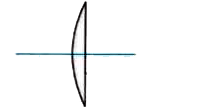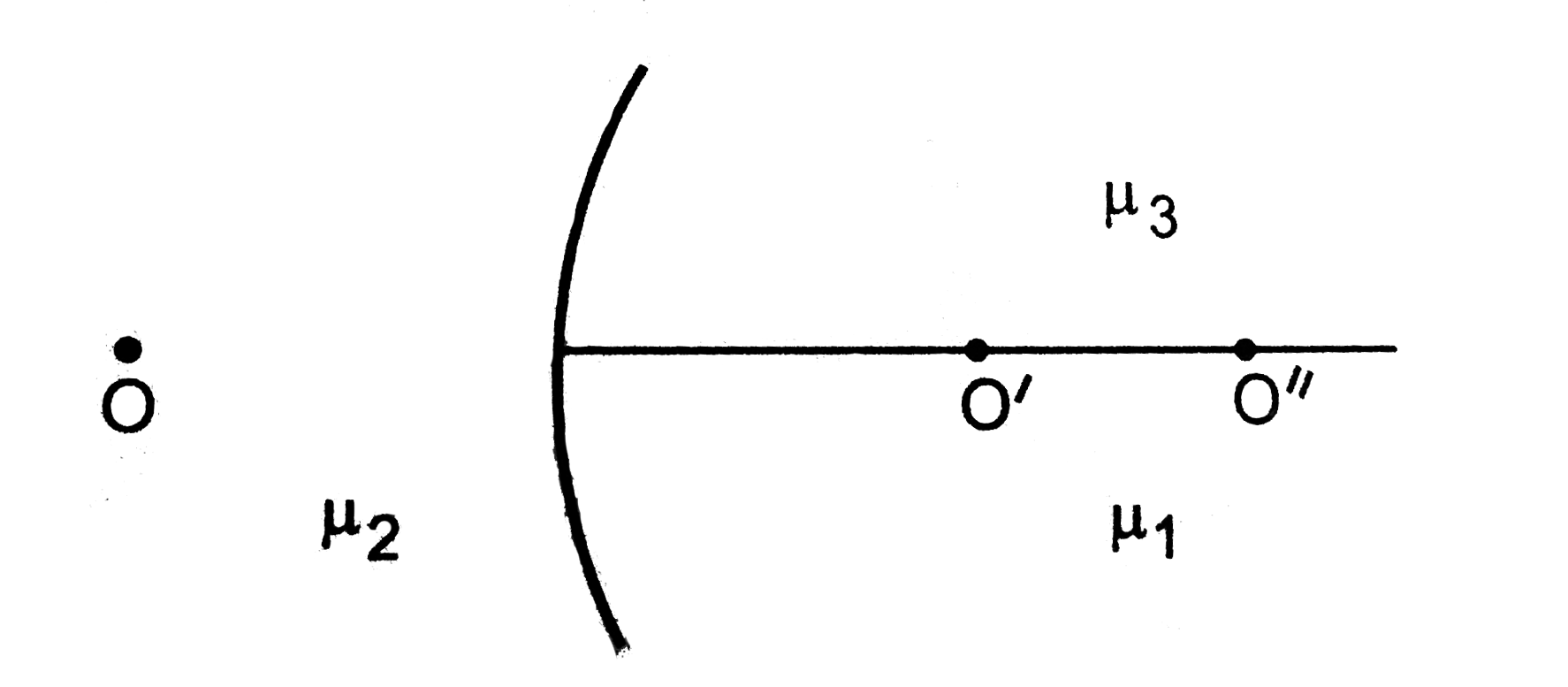Complete Solutions to OBJECTIVE TYPE QUESTIONS (A. MULTIPLE CHOICE QUESTIONS) of chapter RAY OPTICS AND OPTICAL INSTRUMENTS of Class 12 book with complete answers and questions
| Class 12 | PHYSICS |
| Chapter | RAY OPTICS AND OPTICAL INSTRUMENTS |
| MODERN PUBLICATION | OBJECTIVE TYPE QUESTIONS (A. MULTIPLE CHOICE QUESTIONS) |
| Number Of Questions | 40 |
| Academic Year | 2023-24 |
Plane mirror may form a real image at finite distance from it,
View SolutionTotal internal reflection may be observed if
View SolutionWhen light rays are incident on a thick transparent slab then these rays are partly reflected and partly refracted into the slab. At a certain angle of incidence `theta`, it is found that reflected and refracted rays are mutually perpendicular. What is refractive index of material ?
View SolutionWhen we do calculation for image location from spherical mirrors then normally we consider paraxial rays only, because paraxial rays
View SolutionConsider a situation when light ray is travelling from optically denser medium to rarer medium. Critical angle for this pair of mediums is ` theta`. What is the maximum possible angle of deviation suffered by light ray ?
View SolutionImage formed by a convex mirror is
View SolutionThe image formed by a convex lens
View SolutionA medium of refractive index `mu` is separated from air using a plane surface. When light ray is incident on this medium at an angle `70^(@)` then it is found that refracted and reflected ray suffer equal deviations in opposite directions. What is refractive index of material ?
View SolutionA converging lens forms a real image `I` on its optic axis. A rectangular galss slab of refractive index `mu` and thickness `t` is introduced between the lens and `I`. `I` will move
View SolutionFind the focal length of plano-convex lens of material having refractive index of 1.5. Radius of curvature of convex surface is 10 cm.

View SolutionA piece of glass is not visible in a colourless transparent liquid. It is possible because
View SolutionThere is a sphere of radius R and refractive index `mu`. At what distance from the surface of sphere should an object be placed so that real image is formed at the same distance from the sphere ?
View SolutionWhich of the following depend on whether rays are paraxial or not for spherical mirrors ?
View SolutionScreen is placed at a distance 60 cm from an object. A convex lens of focal length f is placed between object and screen and it is attempted that real image of object is formed on the screen. But real image could not be formed for any position of lens between object and screen.
View SolutionAn air bubble inside water. The refractive index of water is 4/3 . At what distance from the air bubble should a point object be placed so as to form a real image at the same distance from the bubble:-
View SolutionAn object is kept at a distance 20 cm from a convex mirror of focal length 20 cm. The image will form at
View SolutionA point source of light is kept on the surface of a sphere and it is found that parallel light rays emerge from the other side of the sphere. What is refractive index of material of the sphere ?
View SolutionTwo concave lenses are kept in contact and magnitude of equivalent focal length is found to be `f_(1)`. Now the space between two lenses is filled with liquid of refractive index slightly more than 1. The magnitude of focal length of combination becomes `f_(2)`.
View SolutionFocal length of a double convex lens is 20 cm in air. If this lens is dipped in water of refractive index `4//3` then what will be the new focal length ? (Take `mu_(glass) = 1.5`)
View SolutionA thin lens is made of glass of refractive index 1.6. Both the surfaces of lens are convex. When this lens is dipped in water of refractive index `4//3` then the lens will behave like
View SolutionTwo thin concave lenses of focal lengths 10 cm and 30 cm and a thin convex lens of focal length 30 cm are kept in contact. What will be the power of lens combination ?
View SolutionThere is a convex lens of focal length 20 cm and a point object is placed at a distance 30 cm to the left of the lens. Radius of the lens is 5 cm. A person has placed eye at the right of lens at a distance 75 cm from the lens and at a height h below the principal axis. What can be the maximum value of h so that person is able to see the image ?
View SolutionA very small object of length a is kept along the axis of a concave mirror of focal length y at a distance x from its pole. Approximate size of the image is
View SolutionThere is symmetric bi-convex lens and it is cut in two pieces by a plane containing principal axis. If power of the original lens is 10 D then what will be the power of each part ?
View SolutionThere is a symmetric bi-convex lens and it is cut in two equal parts by a plane passing through the centre of lens and perpendicular to its principal axis. If power of original lens is 10 D then what will be the power of each part of the lens ?
View SolutionThere is an equilateral prism of material of refractive index 1.5. Light ray is incident normally on its surface. What will be the angle of deviation of ray ?
View SolutionAn object of height 0.5 m is placed in front of convex mirror. Distance of object from the mirror is equal to the focal length of the mirror. Height of the image of the object is
View SolutionA point object is placed in front of a concave mirror. And its image is found to coincide with its own position. Now a glass slab of thickness 15 cm and refractive index 1.5 is placed in between object and the mirror. In order to form image again at the location of object, it is required to move the object
View SolutionThere is a plane mirror at the bottom of tank filled with water having refractive index `4//3`. A point object is placed at a height 10 cm above the bottom. What will be the apparent distance between point object and its image in plane mirror as observed by an observer outside the liquid in air ? Line joining observer and object is normal to the surface of water.
View SolutionFigure shows figure three transparent medi of refractive indices `mu_1, mu_2 and mu_3`. A point object O is placed in the medium `mu_2`. If the entire medium on the right of the spherical surface has refractive index `mu_1`, the image forms at O. If this entire medium has refractive index `mu_2` the image form at O''. In the situation shown

View SolutionA ray of light is incident normally normallyh on one of the faces of a prism of apex angle `30^(@)` and refractive index `sqrt(2)`. The angle of deviation of the ray is `"________________"` degrees.
View SolutionThere is one bi-concave lens of material having refractive index of 1.3. This lens is now dipped in a transparent liquid of refractive index 1.4. Lens will now behave as :
View SolutionThere is a thin prism of angle `5^(@)` made of material having refractive index 1.6. There is another thin prism made of material of refractive index 1.8. These two prisms are combined in such a manner that they may produce dispersion without mean deviation. What should be the angle of second prism ?
View SolutionThe rays of different colours fail to converge at a point after going through a converging lens. This defect is called
View SolutionPerceived size of an object by a person depends mainly on
View SolutionTo increase angular magnification of magnifying glass, we should increase its
View SolutionDistance between eye lens and its retina is.x. Maximum possible focal length of eye lens for a normal person
View SolutionMagnification achieved by an astronomical telescope is 6 when final image is formed at infinity. Distance between objective and eyepiece is 49 cm. Calculate focal lengths of objective and eyepiece.
View SolutionWhen a person is looking at objects kept at different distances then which one of the following factors remains constant ?
View SolutionA person wears glasses with power -2.5 D. Without glasses the person
View Solution
OBJECTIVE TYPE QUESTIONS (A. MULTIPLE CHOICE QUESTIONS) questions and complete solutions for chapter RAY OPTICS AND OPTICAL INSTRUMENTS of MODERN PUBLISHERS PHYSICS (HINGLISH) of Class 12
All Exercises from MODERN PUBLICATION Class 12 PHYSICS RAY OPTICS AND OPTICAL INSTRUMENTS
- CHAPTER PRACTICE TEST
- Conceptual Questions
- Higher Order Thinking Skills & Advanced Level (QUESTIONS WITH ANSWERS)
- NCERT (EXemplar Problems Obejective Questions) (Multiple Choice Questions (Type-I)
- NCERT (EXemplar Problems Obejective Questions) (Multiple Choice Questions (Type-II)
- NCERT (Exemplar Problems Subjective Questions) (Very Short Answer Type Questions)
- NCERT FILE SOLVED (TEXT BOOK EXERCISES)
- OBJECTIVE TYPE QUESTIONS (A. MULTIPLE CHOICE QUESTIONS)
- OBJECTIVE TYPE QUESTIONS (ASSERTION REASON TYPE QUESTIONS)
- OBJECTIVE TYPE QUESTIONS (B. MULTIPLE CHOICE QUESTIONS)
- OBJECTIVE TYPE QUESTIONS (C. MULTIPLE CHOICE QUESTIONS)
- OBJECTIVE TYPE QUESTIONS (D. MULTIPLE CHOICE QUESTIONS)
- OBJECTIVE TYPE QUESTIONS (INTEGER TYPE QUESTIONS)
- OBJECTIVE TYPE QUESTIONS (JEE (ADVANCED) FOR IIT ENTRANCE)
- OBJECTIVE TYPE QUESTIONS (JEE (MAIN) & OTHER STATE BOARDS FOR ENGINEERING ENTRANCE)
- OBJECTIVE TYPE QUESTIONS (MATCHING TYPE QUESTIONS)
- OBJECTIVE TYPE QUESTIONS (MATRIX MATCH TYPE QUESTIONS)
- PRACTICE PROBLEMS (1)
- PRACTICE PROBLEMS (10)
- PRACTICE PROBLEMS (11)
- PRACTICE PROBLEMS (2)
- PRACTICE PROBLEMS (3)
- PRACTICE PROBLEMS (4)
- PRACTICE PROBLEMS (5)
- PRACTICE PROBLEMS (6)
- PRACTICE PROBLEMS (7)
- PRACTICE PROBLEMS (8)
- PRACTICE PROBLEMS (9)
- Revision Exercises (Additional Questions)
- Revision Exercises (Fill in the Blanks)
- Revision Exercises (Long Answer Questions)
- Revision Exercises (Numerical Problems)
- Revision Exercises (Short Answer Questions)
- Revision Exercises (Very Short Answer Questions)
- SOLVED EXAMPLES
- Tough & Tricky (PROBLEMS)